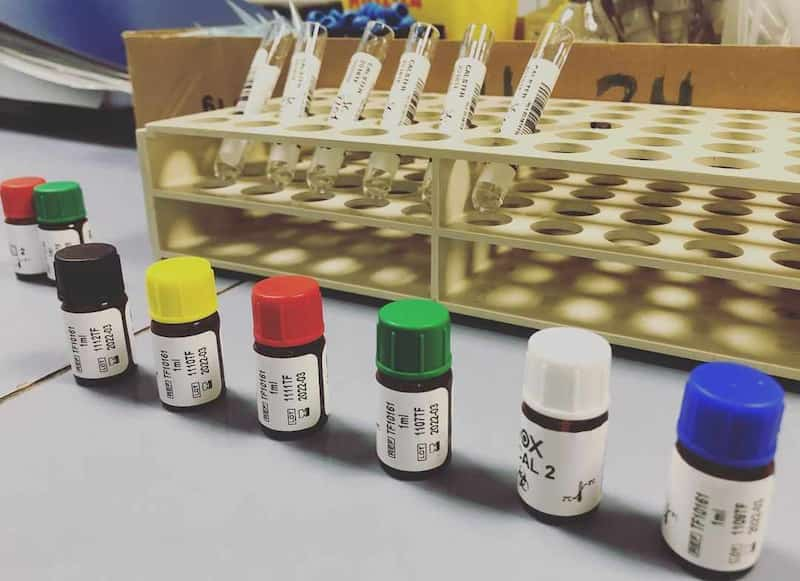Content :
◉ What is HDL-cholesterol ?
The HDL-cholesterol test, also known as the high-density lipoprotein test, is a blood test that measures the levels of HDL-cholesterol in the bloodstream.
HDL-cholesterol is often referred to as "good cholesterol" because it plays a protective role against heart disease; it helps remove excess cholesterol from the bloodstream and transports it back to the liver for processing and elimination.
HDL test is part of a complete lipid profile test, which also includes measuring total cholesterol, LDL-cholesterol, and triglycerides.
The HDL test determines your risk of developing heart disease and other problems related to high cholesterol.

◉ What is the test used for?
The HDL-cholesterol test is used for assessing your cardiovascular health and allowing the doctor to understand the relative amounts of good and bad cholesterols.
Testing HDL-cholesterol can play a role in screening, monitoring, and diagnosing problems that affect your heart, blood vessels, and blood circulation.
People with high blood triglycerides usually also have lower levels of HDL.
The amount of iron that can be bound to transferrin, added to the iron already bound, represents the total iron binding capacity (TIBC). The ratio of serum iron level to TIBC represents the transferrin saturation coefficient.
◉ What is the importance of the HDL-cholesterol?
HDL-cholesterol serves several important functions in the body and plays a crucial role in cardiovascular health. The uses and functions of HDL-cholesterol include:
- Iron Status Assessment: The transferrin test helps evaluate a person's iron status.
- Anemia Evaluation: Transferrin measurements are often used alongside other iron-related tests to help diagnose and differentiate various types of anemia.
- Liver Function Assessment: Since transferrin is primarily synthesized by the liver, the transferrin test can provide insights into liver function.
- Nutritional Assessment: Transferrin levels can be influenced by nutritional factors, such as protein malnutrition and chronic liver disease-related malnutrition.
◉ How can I prepare for the test?
To prepare for the HDL-cholesterol test, you should follow the instructions given by your doctor. These may include:
- Not taking certain medications for a short period before the test.
- Fasting for 8 to 12 hours before the test. This means not eating any food and drinking only water.
- Avoiding alcohol and fatty foods before the test.
◉ Normal range of HDL-cholesterol
The normal range of the HDL-cholesterol test depends on your age, sex, and other factors. Generally, higher levels of HDL are better for your health.
- For adults, the acceptable range for HDL-cholesterol is 40 mg/dL or higher for men and 50 mg/dL or higher for women.
- For teens and children, the acceptable range for HDL-cholesterol is 45 mg/dL or higher.
- For people with diabetes, high blood pressure, or a family history of heart disease, the acceptable range for HDL-cholesterol is 60 mg/dL or higher.
◉ High values of HDL-cholesterol
1. Causes of high transferrin levels
Higher levels of HDL-cholesterol are associated with a lower risk of heart disease and stroke. However, there are causes of the HDL-cholesterol level such as;
- Some people have naturally higher or lower levels of HDL-cholesterol due to their genes.
- Your lifestyle choices, such as your diet, exercise, smoking, alcohol consumption, and stress levels, can also influence your HDL-cholesterol level.
2. Symptoms
The symptoms of the high HDL-cholesterol levels are usually not noticeable.
◉ Low levels of HDL-cholesterol
◉ 1. Causes
Causes and associated factors of low HDL-cholesterol levels may include:
1. Genetics: Some individuals may have a genetic predisposition to low levels of HDL-cholesterol.
2. Unhealthy Lifestyle Factors: Modifiable lifestyle factors that can contribute to low HDL-cholesterol levels include:
- Sedentary Lifestyle: Lack of physical activity or exercise.
- Poor Diet: Consuming a diet high in saturated fats, Trans fats, and processed foods.
- Obesity
- Smoking
- Excessive Alcohol Consumption.
3. Underlying Medical Conditions: Certain medical conditions or medications may contribute to low HDL-cholesterol levels, including:
- Type 2 Diabetes
- Liver Disease
- Metabolic Syndrome: including high blood pressure, high blood sugar, excess abdominal fat, and abnormal cholesterol levels.
- Medications: Some medications, such as beta-blockers and anabolic steroids.
◉ 2. Symptoms
Symptoms of low HDL-cholesterol levels are usually not noticeable by themselves, but they may increase the risk of developing heart disease and other complications, such as premature coronary artery disease, heart attack, stroke, peripheral polyneuropathy, heart failure, and diabetes.
◉ Are extremely low of HDL-cholesterol dangerous?
Yes, extremely low values of the HDL-cholesterol test can be dangerous for your health. Low levels of HDL-cholesterol can increase your risk of developing heart disease, stroke, and other complications. However, it's important to note that HDL-cholesterol alone is not the sole determinant of cardiovascular risk.
◉ How to improve HDL-cholesterol naturally?
To improve your HDL-cholesterol levels, you should follow a healthy lifestyle that includes eating a balanced diet rich in fruits, vegetables, whole grains, and healthy fats, exercising regularly, quitting smoking, losing excess weight, and managing your stress levels.
◉ Additional tests
- Lipid profile or lipid panel: This is a group of tests that includes the total cholesterol, HDL-cholesterol, LDL-cholesterol, and triglycerides tests. It can provide a more comprehensive picture of your blood lipid levels and your risk of heart disease and stroke.
- Apolipoprotein A1 (Apo A1) test: This test measures the level of apolipoprotein A1 in your blood. Apolipoprotein A1 is the main protein component of HDL-cholesterol.
- Apolipoprotein B (Apo B) test: This test measures the level of apolipoprotein B in your blood. Apolipoprotein B is the main protein component of LDL-cholesterol
◉ Conclusion
The HDL-cholesterol test provides valuable information about an individual's cardiovascular health and helps assess their risk for heart disease.
By monitoring HDL-cholesterol levels and making appropriate lifestyle modifications, healthcare professionals can work with patients to reduce their risk of developing cardiovascular problems and promote overall heart health.